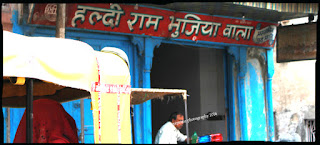Bhujiawala’s humble abode - Bikaner
by Moutushi Ghoshdeysarkar
Of Haveli’s and forts and temples
we talk, as we try to picture Rajasthan, but we forget that the most used
snacks without which the drinks gets boring is also a gift of Rajasthan, mainly
Bikaner, within 200kms of Pakistan, amidst the desert.
Bikaner was called Jangladesh, it
is in the Thar desert and was completely baron but the one thing which made it
an oasis on the trade route between the Gujarat coast and central Asia, were
its natural springs.
Rao Bika was the eldest son of
Maharaja Rao Jodha of the Rathore clan of Jodhpur and wanted a kingdom for
himself. So he built a fort in Bikaner 250 kms north-west of Jodhpur and
established a city. As any city in the trade route, Bikaner prospered but it
was not until the times of the sixth Raja, Rai Singhji, when the city’s fortune
flourished. Raja Rai Singhji was an army general at the court of Emperor Akbar
and Jahangir. He had won many accolades in the war fought for the Mughals and
thus received jagirs from the emperor.
These jagirs earned him huge
revenues and he was able to build the beautiful Junagarh Fort (Chintamani
Durg). Subsequent rajas added new palaces to the fort and decorated it further.
The Bikaner Rajas accepted the suzerainty of the British after the Mughals and
thus have been always wealthy and prosperous. After independence the then Maharaja,
Lieutenant General Sir Sadul Singh acceded the princely state of Bikaner to the
Union of India. The last Raja Dr. Karani Singh had fought in the Second World War
and was member of the Indian parliament for 25years. Now the royal family lives
in a suit at the Lalgarh palace which they have turned into a luxury hotel.
Rajas, royalty and their
prosperity, more or less the same story all over the world but Bhujiyas and
bhujiyawalas are unique to Bikaner. It all started here. Bhujiyas, delicious, can
be preserved for days and a little quells the hunger, made a wonderful carry on
food through the desert where caravanserais are distant and infrequent.
Born in 1877, when the first moth bean,
chana daal, powdered cellulose, red chilli, black pepper, cardamom and so many
other condiments mixed together, went through the sieve into the frying pan,
the Bhujiya finally got the Geographical Indications rights and patents in 2010,
so none other than the local manufacturers can call their bhujiya, Bikaneri
Bhujiya.
Mouth watering kulfi, crispy
kachori, tasty puri and multicoloured dry sweets are among the tourist
attractions in Bikaner.
The casse-croûte
is one of the major cottage industries in Bikaner employing more than 2.5
million people, the other things people are involved in is making kundan jewellery,
lac ornaments, leather products, wool craft, carpets, leheriya and tie and dye
fabric, quills and bedspreads.
These skills have been passed on
for generations, from the intricate carvings in the palaces and temples to the
precision of the needle as it moves and the mixture as it goes through the sieve.
Camel is another important element of dwelling in Bikaner. Ganga Risala an elite camel corps unit in the Bikaner Army participated in both the World Wars and for the Indian Army in the Indo-Pak war. Bikaner is the only place to have a camel research farm and breeding centre in India and one of the biggest in the world. Varied varieties of camels are housed in the research centre, one humped, two humped, kachchi, Jaisalmeri, Bikaneri and many more. Camel milk products are available at the research centre for the tourist which is extremely delicious. Camel bones from the dead camels can replace ivory and stop the killing of the tuskers.
Bikaner, a vertex of the golden
triangle is a thriving city of more than 6.5Lakhs people is distinctly divided
into the old and the new city. The old city boasts of exquisitely carved and
intelligently designed Havelis of the rich, narrow galis (lanes), bazaars and
tightly packed houses of the common man most likely to fend against the heat
and desert storms. It is bordered by the Gorgeous Junagarh Fort. The new city
has wide roads, havelis and palaces converted into luxury hotels lining them, eateries
with an old world charm and glittering street lights.
Many a beautiful and unique
attraction can be attempted with Bikaner as the starting point, like Karani
Mata temple, the safest haven for the rodents some 35kms away towards Nagaur, Gajner
palace by the lake, once a hunting lodge of the maharajas, now converted into
an opulent hotel, another 35 kms on road to Phalodi, the first monument constructed
by Rao Bika, the Kodamdeshwar Temple some 24kms to the west and ofcourse the
beautiful cenotaphs in a serene surrounding.
Delighted to have visited this
colourful and humble abode of the Bhujiawalas. Please feel free to get in touch
for further queries: moutushig@gmail.com














So interestingly packed with information. Thank you for the good read!
ReplyDeleteThanks for dropping by at the blog... am so happy you liked it.
ReplyDeleteInformative keep travelling and writing :)
ReplyDeleteThanks a bunch, will definitely try... inspired by lovely people like you.
DeleteMost beautiful written , well articulated. Thanking my friend Ruma for sharing this.
ReplyDeleteThank you so much Sonika. Inspiring for a budding blogger.
Delete